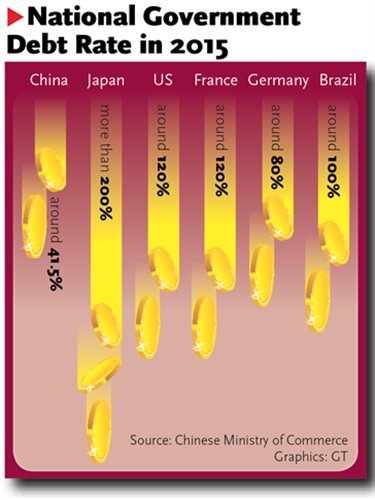
New investigation will help government address issue: experts
Experts said China's local-held debt is still within a "controllable range," after Beijing-based China Times reported mounting pressure on local governments over their ability to pay off debts as revenues from land sales and administrative fees drop and after an investigation has been opened up by the Ministry of Finance (MOF).
The finance ministry began on a new round of investigations into the outstanding debt held by local government financing vehicles (LGFVs) and State-owned enterprises, the Guangzhou-based 21st Century Business Herald reported on October 18.
The investigation aims to garner updated data on the scope of China's local debt issue, as local governments turn to covert financing channels to cope with their vast need for capital. This practice has made local debt figures prone to changes over just a few months, the China Times reported, citing an unnamed source close to the ministry.
According to the 21st Century Business Herald, the MOF investigation is looking at various funding sources for LGFVs, including bank loans, bonds, as well as non-bank creditors.
The China Times reported that the decline in revenues from land sales, taxes and administrative fees has significantly compromised local government solvency.
As of September 2, bond issuance by Chinese local government investment vehicles surpassed 1.2 trillion yuan ($177 billion), a greater amount than for the whole of 2015, according to a Reuters report.
Controllable situation
An expert told the Global Times Sunday that the local debt issue in China is still within control of the central government.
Jiang Zhen, a research fellow at the National Academy of Economic Strategy at the Chinese Academy of Social Sciences, said the new, systematic survey is a way to grasp the structure of the debt and proportion of debt due in the near term and in the long term.
"Surveys of this kind help the central government oversee the payment of local debt at the national level," Jiang told the Global Times.
In 2015, China's local debt ratio stood at 89.2 percent, lower than the international alert level of 100 percent, the Economic Daily reported in May, citing sources from the MOF.
However, the economic slowdown had dented solvency in some regions and pushed their local debt ratio above 100 percent, the report said.
The risk of local debt will have to be accessed based on its usage and source of payment, according to Jiang.
Generally speaking, the risks are low and most of the risks are from a mismatch in the timeframe of debt and the project's pay-off period, he said.
"A fundraiser will face problems when it raises short-term debt for investment projects that only start to pay off in the long term," Jiang said.
"The prevalent situation in China is that money was raised for productive purposes, rather than consumption, and resulted in assets, such as infrastructure, which could generate cash flow over the years as the guaranteed source of payment," Jiang said, noting that risks would be low this way.
Addressing the debt
Dong Dengxin, a professor at Wuhan University of Science and Technology, said in addition to central government supervision, self-discipline by the local governments is required and they need to analyze their solvency carefully and meticulously when issuing bonds.
"All cities leverage. Some cities face controllable risk, others face uncontrollable risks, as their overall strengths differ. The central government would find it difficult to roll out a one-size-fits-all policy on the matter," Dong told the Global Times Sunday.
Since 2015, the Chinese government has run a debt swap program that aims to reduce the pileup of LGFVs.
LGFVs function as a vital channel in supporting China's State-sector investment, but have been a source of non-performing debt in the past, according to media reports.
"Currently, reform is focused on digesting the historic problems left over by the LGFVs. When the new model is set up and a lenient cycle is rolling, the nature of local government debt will not be so pessimistic," Dong said.
Also, according to Jiang, local governments have deep pools of resources, which can be turned into payment at times of necessity if revenue can not cover debt payment.
Both Jiang and Dong said revenue from land sales have helped to pay off local debts but is not sustainable, due to the uncertainty in the real estate sector.


















































